Solutions of Electricity (Page No- 41) - Physics By Lakhmir Singh, Class 10 | Extra Documents, Videos & Tests for Class 10 PDF Download
Lakhmir Singh Physics Class 10 Solutions Page No:41
Question 29:
A 5 V battery is connected to two 20 Ω resistors which are joined together in series.
(a) Draw a circuit diagram to represent this. Add an arrow to indicate the direction of conventional current flow in the circuit.
(b) What is the effective resistance of the two resistors ?
(c) Calculate the current that flows from the battery.
(d) What is the p.d. across each resistor ?
Solution :
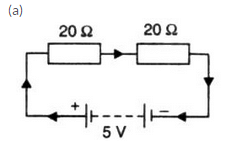

Question 30:
The figure given below shows an electric circuit in which current flows from a 6 V battery through two resistors.
(a) Are the resistors connected in series with each other or in parallel ?
(b) For each resistor, state the p.d. across it.
(c) The current flowing from the battery is shared between the two resistors. Which resistor will have bigger share of the current ?
(d) Calculate the effective resistance of the two resistors.
(e) Calculate the current that flows from the battery.
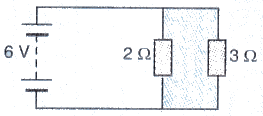
Solution :
V = 6V. R1 = 2ohms. R2 = 3ohms
(a) Resistors are connected in parallel
(b) p.d. across each resistor is same and is equal to 6V.
(c) 2 ohms resistance have bigger share of current because of its lower resistance.
(d) Effective resistance = R
1/R = 1/2+1/3
1/R = S/6
R = 1.2ohms
(e) Current flowing through battery, l = V/R = 6/1.2 = 5amps
Question 31:
A 4 Ω coil and a 2 Ω coil are connected in parallel. What is their combined resistance ? A total current of 3 A passes through the coils. What current passes through the 2 Ω coil ?
Solution : 40 and 2Ω coil are connected in parallel. Combined resistance is R


Question 32:
(a) With the help of a circuit diagram, deduce the equivalent resistance of two resistances connected in series.
(b) Two resistances are connected in series as shown in the diagram 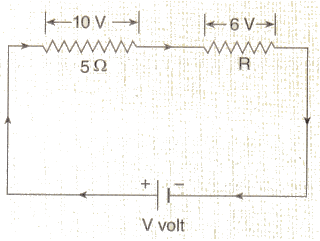
(i) What is the current through the 5 ohm resistance ?
(ii) What is the current through R ?
(iii) What is the value of R ?
(iv) What is the value of V ?
Solution :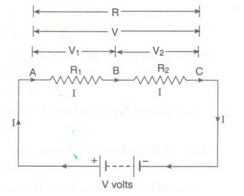
(a) Fig shows two resistances R1 and R2 connected in series with a battery of V volts.
Let the p.d. across R1 is V1 and the p.d. across R2 is V2.
S.t. V = V1 + V2 ....... (1)
Let the equivalent resistance be R and current flowing through whole circuit is I.
By Ohm's law,
V/I = R
V = I x R ---------(2)
Applying Ohm's law to both R1 end R2
V1 = I x R2 --------(3)
V2 = I X R2 ----- —(4)
From eqs. (1), (2), (3) and (4), we get
I x R = I x R1+ I x R2
I x R = I x (R1 + R2)
R = R1 + R2
(b)
(1) Current through 5Ω resisto r= 10/5 = 2A
Since 5Ω resistor and R are connected in series, so same current flows through them.
So, Current through R = 2A
(iii) V = IR
R = V/I = 6/2 = 3Ω
(iv) V = 10 + 6 = 16V
Question 33:
(a) With the help of a diagram, derive the formula for the resultant resistance of three resistors connected in series.
(b) For the circuit shown in the diagram given below :

Calculate :
(i) the value of current through each resistor.
(ii) the total current in the circuit.
(iii) the total effective resistance of the circuit.
Solution :
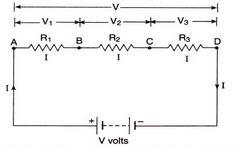
(a) Ng shows three reSistances R1, R2 and R3 ecnnected in series with a battery of V volts.
Let the p.d. across R1, R2 and R3 is V1, V2 and V3 respectively.
s.t. V = V3 + V3 + V2 ----(1)
Let the equivalent resistance be R and arrent flowing through whole circuit is I.
By Ohm's law,

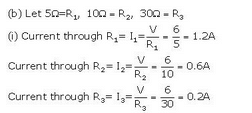
(ii) Total current in the cirait = 1.2+0.6+0.2 = 24
(iii) Effective resistance R is given as
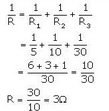
|
5 videos|292 docs|59 tests
|
FAQs on Solutions of Electricity (Page No- 41) - Physics By Lakhmir Singh, Class 10 - Extra Documents, Videos & Tests for Class 10
| 1. What is electricity? |  |
| 2. How is electricity generated? |  |
| 3. What are the different types of electricity? |  |
| 4. What are the units used to measure electricity? |  |
| 5. How does electricity travel through a circuit? |  |























